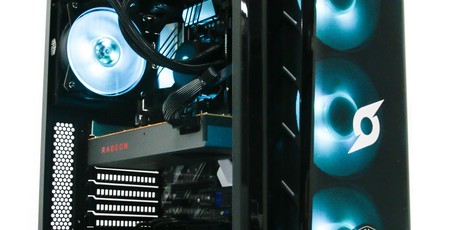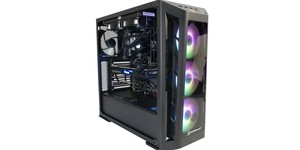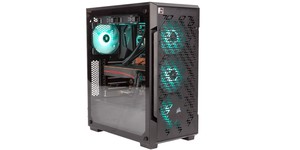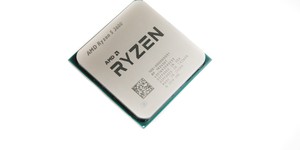Stormforce Crystal 3600 RX 5700 Review
October 21, 2019 | 09:30
Companies: #amd #asus #cooler-master #fsp #hyperx #kingston #stormforce #wd

Performance Analysis
We'll start with the stress testing (Prime95 + FurMark) in which the CPU reached a peak temperature of 78°C with an ambient room temperature of 21°C. It's a reasonable result but one that is maybe not leaving as much headroom as we initial thought for overclocking. On the flip side, the out-of-box configuration is more than up to the task of handling lengthy multi-threaded workloads.
The GPU temperature hit a slightly more concerning 82°C. This was admittedly in FurMark, but clearly on a warmer day during a lengthy gaming session, we'd have concerns here about the card throttling and limiting performance just as we did with the Novatech Elite Spectre and its reference RX 5700 XT. It's a quieter card here for sure on account of the less power-hungry GPU, and in fact the whole system was pleasant to sit next to even under full load, but we'd nevertheless always prefer to see a more elaborate cooler strapped to any Navi card. Good news, then, that Stormforce will soon be swapping to the Asus RX 5700 Dual Evo OC for this system at no extra cost - we suggest contacting the company to confirm. Naturally, we are unable to comment on how it holds up under stress testing; Stormforce found that it 'offered some very minor performance gains but presented a worthwhile thermal benefit as well as a significant reduction in noise'.

Stepping down from the Novatech system sees the 99th percentile minimum frame rate fall from 41fps to 36fps in Metro Exodus at 1080p with the slower Navi card, so not a massive drop considering the £500 system price difference, although in percentage terms that does come to around 14 percent. It was a similar story at 1440p, with the Stormforce system just topping 30fps on the minimum 99th percentile with an average of 51fps - still perfectly playable despite the demanding game. We choose this benchmark as a worst-case scenario, so it means that the majority of modern games at 1440p will be sat within the 30-60fps window if not higher, even with maximum settings.
Total War: Three Kingdoms is further proof of 1440p playability; at this resolution, the RX 5700 managed an average frame rate of 44fps versus 50fps for the pricier RX 5700 XT-based system. There were similar falls in Fire Strike, Time Spy, and VR Mark, where the Ryzen 5 3600 often played a part in toppling Core i5-9600K/RTX 2060 systems. We do not expect the Asus card mentioned above to make any significant difference to in-game performance, so the results here can be considered as applying to both.
The extra cores and higher clock speeds of the Ryzen 7 3700X allowed the pricier Novatech system to edge out big leads in HandBrake and Cinebench, which is clearly where some of your extra cash is going, and PCMark 10's image editing test also showed big gains, which is expected since this workload also taps into GPU acceleration. The Ryzen 5 3600 is not much of a limit in games, even at stock speed, but in content creation workflows like these it's worth considering a system with a beefier CPU.

The WD Blue SN500 is one of the slower NVMe drives out there right now thanks to a PCIe 3.0 x2 interface, and the difference between it and the PCIe 4.0 SSD in the Novatech system was stark with read and write speeds of 1,643MB/s and 1,301MB/s versus 4,969MB/s and 4,263MB/s respectively and noticeable gains on the random speeds too for the PCIe 4.0 drive. This is further proof that using a PCIe 4.0-enabled X570 motherboard was ill-advised. As usual, though, it's only likely in large file transfers that you'll notice anything significant between the two; the PCMark 8 workloads demonstrate this nicely, and the biggest advantage for the Novatech system is that it has a far healthier 1TB of space as opposed to the bare minimum 250GB SSD Stormforce has used.
Finally, the power consumption was around 60W less than the Novatech PC under full load at 355W. Given that's with both the CPU and GPU at full load, that means there's ample headroom for overclocking with the PSU's 500W capacity. Again, this should not be drastically affected by the swap to the Asus GPU.

Conclusion
There's a lot to like with the Crystal 3600 RX 5700. It's quiet, looks good, and has an excellent warranty too. Totalling up the components and OS, you're looking at around £1,120 if you go the DIY route. For the extra £180 you're getting that three-year warranty (with favourable terms that PCSpecialist charges over £150 for, so don't take it lightly) and a system delivered to your door. There are no major flaws in the build quality, and the cooling configuration is adequate in terms of CPU temperature and total noise, but cable routing appears to have gone slightly south since we last saw a Stormforce system. Aesthetics are mostly done right, though the blue PCB on the SSD and may irk the more obsessive customer, likewise with the red Radeon logo and lack of GPU backplate. The green Wi-Fi card is old stock; Stormforce has already migrated to using black PCBs, so that's one less worry at least.
As mentioned, the component choices here are locked down and not open to customisation, so we (and you) have every right to nitpick. On that note, we'd maybe have liked to see a CPU overclock and 3,600MHz memory. Primarily, though, we definitely wanted to see a larger SSD. The 250GB model is particularly disappointing in the face of recently confirmed game install sizes and given that we called Stormforce out for this last time on a £300 cheaper system. Dropping to a lesser chipset would have gone a long way toward making space in the budget for this. Then there's the graphics card, which wasn't quite as loud as we'd feared, but the temperatures are concerning, and practically any third-party offering would be superior on both fronts of noise and thermals (and arguably aesthetics).
Thankfully, Stormforce will be swapping to the Asus RX 5700 Dual Evo OC for no additional cost once reference stock is depleted. However, the size of the primary SSD is still a large fly in the ointment of a PC that otherwise is solid and justifies its price tag once the warranty is factored in. As such, we're not quite able to stretch to an award this time around.
Response from Stormforce
Update 21/10/2019: Stormforce has responded to the review with comments on some of the feedback we gave the product. Parts of this response are reproduced below with Stormforce's permission.
'Regarding SSD and Motherboard combination and choices, we had extensively tested Zen 2 across B450, X470 and X570. We made the decision to use X570 in our higher-end systems, as it made sense to ensure that the CPU's PCIe 4.0 was available to an end user should they wish to add this technology when it reaches a point where it is more affordable and the market has more options than the currently limited options using the Phison controller.
'Our lower-priced systems do offer B450 paired with the Ryzen 3600 as the lower price point justifies the removal of next gen upgrade paths somewhat.
'We have taken onboard the feedback around storage. It comes at a time where we are reviewing our storage options and looking to improve offerings in this area with Western Digital. Whilst WD doesn’t have a PCIe 4.0 offering currently, capacity will certainly be addressed as a priority.
In regards to cable management, the original system we were sent came in a different chassis that went EOL before the review was started. We asked Stormforce to collect the system and replace the chassis with the new one, as we felt this was too big a change to ignore. According to Stormforce, 'this meant that the returned unit went to our returns department for the rework rather than our production team. Unfortunately, the MB520 was a new unit to them and this meant that the reworked system was assembled and shipped as you found it. We would rarely receive a system into our returns team for a case swap (a like-for-like replacement would be more likely). We have immediately put a process in place to ensure that any returned systems undergo our same QC procedure as a new build. In hindsight, a new system should have been built rather than reworking the original unit, as it circumvented an internal process we wouldn’t usually have anticipated, [and] it is essentially something which would happen so rarely that we simply haven’t addressed it before.'
We thank Stormforce for its detailed, honest feedback.

MSI MPG Velox 100R Chassis Review
October 14 2021 | 15:04








Want to comment? Please log in.